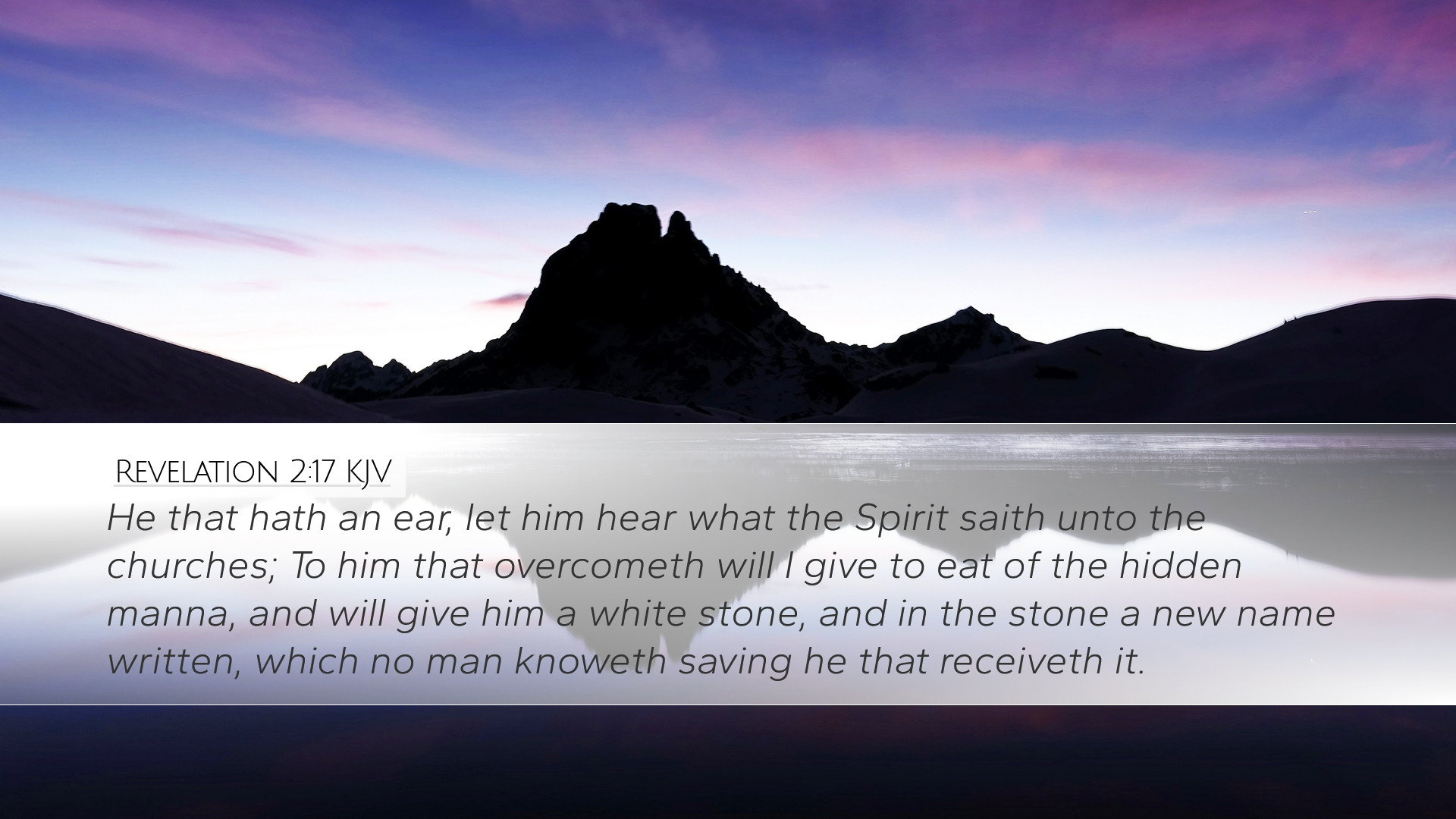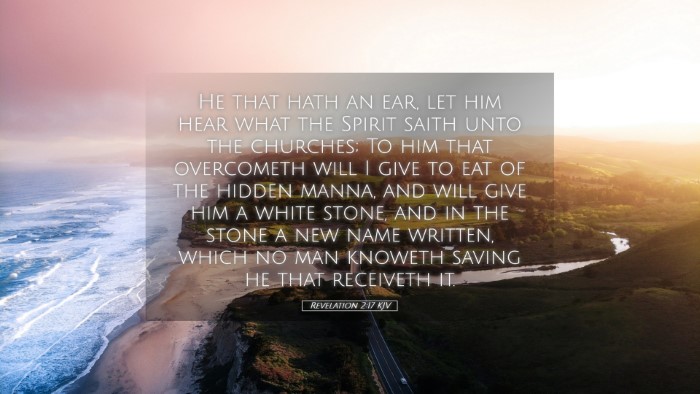Commentary on Revelation 2:17
Text of Revelation 2:17 (KJV): "He that hath an ear, let him hear what the Spirit saith unto the churches; To him that overcometh will I give to eat of the hidden manna, and will give him a white stone, and in the stone a new name written, which no man knoweth saving he that receiveth it."
Introduction
This verse is part of the message to the church in Pergamos, one of the seven churches addressed in the Book of Revelation. Each message contains a call to heed the warnings of Jesus, along with promises for those who overcome. The imagery and symbolism used in this verse hold significant theological and practical implications for the faithful.
The Call to Attentiveness
In the first part of the verse, “He that hath an ear, let him hear,” we see a call for attentiveness to spiritual truths and divine revelations. This phrase appears throughout the seven letters, signaling the importance of listening closely to God’s messages. According to Matthew Henry, this call implies a responsibility to understand and apply God’s word, indicating that spiritual discernment is crucial for believers.
Overcoming and the Promises
The promise “to him that overcometh” suggests not just a passive faith but an active triumph over sin, temptation, and trials. Albert Barnes emphasizes that overcoming necessitates effort and commitment to Christ, meaning that believers are called to resist worldly influences and live according to God’s will.
Adam Clarke adds depth to this interpretation, suggesting that overcoming here relates to faithfulness amid persecution, referencing how many early Christians faced severe trials for their beliefs. Therefore, the promise is both a comfort and an incentive for those facing hardship.
The Hidden Manna
The mention of “hidden manna” is rich in Old Testament symbolism. Manna was the divine provision given to the Israelites in the wilderness (Exodus 16). Matthew Henry notes that the “hidden” aspect denotes a spiritual sustenance that transcends earthly needs, representing Christ as the spiritual food for believers. Jesus Himself referred to being the “bread of life” (John 6:51), indicating that this promise is ultimately fulfilled in Him.
Albert Barnes also speaks to the idea that this hidden manna can symbolize the secret joys and delights of fellowship with God that are not visible to the world. This food nourishes the soul and sustains the believer in their spiritual journey.
The White Stone
The “white stone” is a symbol that has garnered much attention. According to Adam Clarke, the white stone may refer to a judicial acquittal or acceptance. In ancient times, a jury would cast a white stone as a symbol of acquittal and a black stone for condemnation. Thus, the white stone represents the believer's declared righteousness in Christ, celebrating the grace bestowed upon those who overcome.
Matthew Henry expands on this idea by suggesting that the white stone also serves as a means of identification in the Heavenly realm. It is given uniquely to each believer, thus reinforcing the personal relationship each one has with Christ. Moreover, it serves as a reminder of the eternal reward that awaits the faithful.
A New Name
The final part of the verse speaks of a “new name written, which no man knoweth saving he that receiveth it.” This new name signifies a transformation of identity. Albert Barnes suggests it reflects how believers are new creations in Christ (2 Corinthians 5:17). This transformation indicates a deeper, personal relationship with God that goes beyond human understanding.
Adam Clarke mentions the esoteric nature of this name—known only to the receiver—emphasizing a unique and intimate connection that God has with each believer. It encapsulates the individual journey of faith and the distinct purposes God has for each person.
Theological Implications
Theologically, Revelation 2:17 interweaves themes of perseverance, divine provision, and personal redemption. The call to listen is foundational for understanding and responding to the Spirit's guidance, while the promises given signify God’s faithfulness to provide for and recognize His faithful followers. The hidden manna and white stone serve as vivid reminders of the spiritual riches that accompany the believer’s journey.
Moreover, the new name offers comfort and assurance of eternal significance for those who remain steadfast amidst trials. This verse showcases the depth of God’s love and commitment to His people, promising sustenance, acceptance, and transformation for all who overcome.
Conclusion
Revelation 2:17 encapsulates the essence of the Christian experience—an active response to God's call, a promise of sustenance and identity, and a reassurance of spiritual victory. As pastors, students, theologians, and Bible scholars engage with this passage, they are reminded of the beauty and richness of the Christian faith that is both deeply personal and profoundly communal.
Encouragement is found in the reminder that no matter the trials faced, victory in Christ is assured, accompanied by divine provisions and a new identity that reflects the glory of God.


